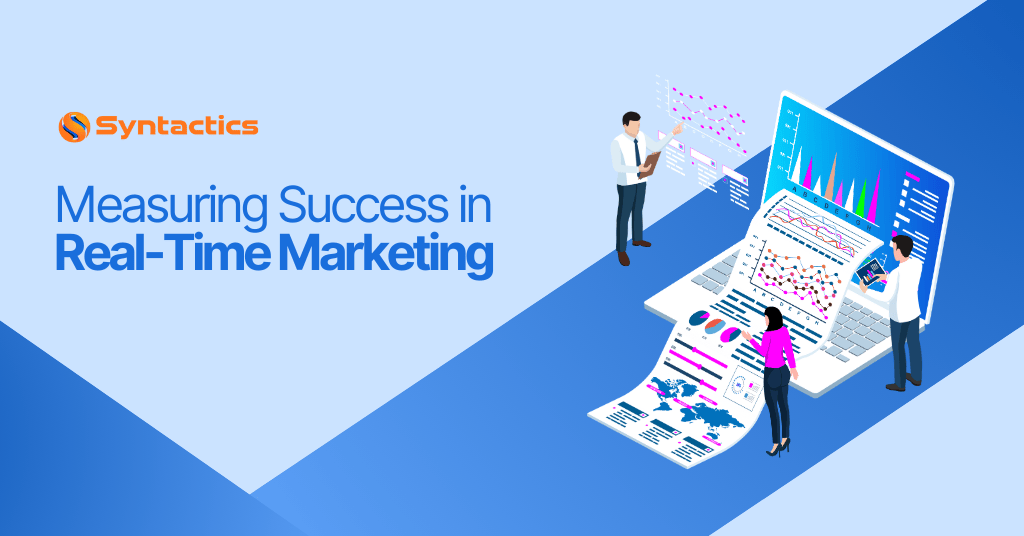
Measuring Success in Real-Time Marketing
Brands today utilize a variety of marketing efforts to attract the attention of potential customers. That being said, they can leverage Real-Time Marketing (RTM). Through this strategy, brands can engage with audiences as current events happen.
RTM, also known as moment marketing, can be a valuable tool for driving engagement and building brand loyalty. Whether it’s responding to viral content or jumping on trending hashtags, it allows marketers to create a more relevant and timely advertising campaign.
To stay on top of current trends, check out these tips for creating viral content:
What is Real-Time Marketing?
RTM is a dynamic approach that involves responding to current events, trends, or consumer interactions as they happen. It requires businesses to be responsive and agile in creating content that’s relevant to current trends.
RTM can come in any form, from social media posts and blog updates to online ads. All are designed to attract audiences while the topic is still fresh. Its goals include the following:
- Engage with audiences in real-time;
- Capitalize on opportunities to increase visibility;
- Drive engagement, and
- Develop a deeper connection with potential customers.
One example of a successful moment marketing campaign is the KitKat ad launched during the Crowdstrike tech outage in July of this year. While it impacted millions of Microsoft users, KitKat’s marketing creatives recognized an opportunity.
The campaign took the blue screen synonymous with the IT outage, turned it red, and added their iconic “Have a break” tagline.
As such, RTM involves a positive approach to newsjacking, using real-time data and analytics.
Elevate Your Business with Content Marketing Services!
Measuring Success in Real-Time Marketing
As with any other marketing strategy, you can measure the success of your RTM campaign to understand what activities are effective and what needs improvement.
Learn more about how to evaluate your digital marketing efforts effectively:
Digital marketing companies utilize the following tools to measure the success of an RTM campaign:
Key Performance Indicators (KPIs)
To gauge the effectiveness of moment marketing campaigns, digital marketers track relevant KPIs (how well a company is progressing towards its business goals), such as:
- Engagement rates (Ex. High likes and shares on a Super Bowl campaign post);
- Social media mentions (Ex. high mentions on a clothing brand’s hashtag campaign);
- Website traffic (Ex. increased visits to a tech product landing page on National Technology Day), and
- Conversion rates (Ex. high conversion rates on food delivery app during BTS concert).
Evaluate ROI and Effectiveness
In addition to KPIs, it’s crucial to evaluate your RTM campaign’s Return on Investment (ROI). By doing so, businesses can refine their strategies and ensure that their advertising efforts are delivering excellent results.
Therefore, it’s vital to consider the following factors when evaluating ROI and the effectiveness of your marketing strategies:
- Competitor analysis (Ex. Analyzing fashion brand’s posts around Met Gala where humorous content generates more engagement);
- Speed of response (Ex. A sports drink company responds within hours of an Olympic event);
- Relevance (Ex. An eco-friendly brand’s Earth Day campaign highlighting sustainability), and
- Overall impact on brand reputation (Ex. A mobile company’s creative response to a new phone model release).
Tools and Technologies for Effective Advertising in Real-Time
Many digital marketers utilize technology to ensure the effectiveness of their RTM campaigns. For instance, these can assist with gathering data, analyzing consumer behavior, and delivering brand messages.
To guide you, here are the best tools for RTM:
Social Media Monitoring Tools
According to Relevant Social Media Monitoring Statistics, 71% of businesses say that social media monitoring offers valuable consumer insights, which they share with teams or departments.
Hence, following conversations and tracking engagement on social media is an effective way to ensure an effective moment marketing strategy.
This is why paying attention to metrics like audience sentiments, social ROI, and social share of voice helps you stay informed about the current trends.
Here are the most recommended social media monitoring tools for RTM:
- Hootsuite;
- Buffer;
- Facebook;
- TikTok;
- Instagram, and
- Google Alerts.
If you want to improve your business’s online presence further, check out how you can leverage social media search engine optimization strategy.
Challenges in Measuring RTM Success
Success in RTM is defined based on how quickly and effectively your brand responds to unfolding events or customer interactions. However, measuring the impact of these strategies presents a unique set of challenges.
Below are the top three obstacles businesses face in measuring RTM success and how to overcome them:
Managing Data Overload
There’s an overwhelming amount of data coming from multiple sources, such as social networks, customer feedback, and analytics.
The main challenge is to find the most useful and relevant channels for your RTM campaign.

Source: Facebook.
Therefore, many digital marketers use the best tools to develop a moment marketing strategy that focuses on relevant metrics. These can include:
- Engagement metrics (likes, shares, comments, etc.);
- Conversion metrics (number of users taking immediate action), and
- Sentiment analysis (response to the campaign).
Maintaining Accuracy and Consistency
Real-time data changes quickly, increasing the chances of inaccuracies, especially if not meticulously managed.
Let’s say that there’s a sudden surge of web traffic to specific content, but it didn’t lead to any conversions or positive sentiment. These specific changes are called vanity metrics, wherein numbers look impressive but don’t translate into meaningful outcomes.
Balancing Speed with Strategy
Marketing in real-time means acting quickly in response to trending topics, social media events, or customer feedback. However, rushing into action without careful consideration can lead to poorly executed campaigns.
For instance, you may quickly respond to a trending event, but this might not align with your brand identity.
To balance speed with strategy, set up predefined responses or content templates for certain types of events.
Businesses can also establish brand guidelines and implement quality control to ensure marketing content aligns with brand strategies.
Conclusion
By marketing in real-time, businesses can engage with their audience on relevant topics. Additionally, they can craft relevant content that attracts attention and encourages interaction.
However, achieving success in moment marketing requires authenticity, relevance, and timeliness. Thus, it can be an overwhelming experience to maintain the momentum while running your business.
Fortunately, an experienced digital marketing company in the Philippines can help you utilize RTM to amplify the success of your business campaigns.
Not only do we utilize effective RTM techniques, but we also have tools and technologies to stay competitive in the ever-evolving digital world.
Frequently Asked Questions About Real Time Marketing
What are the best platforms for moment marketing?
The following platforms are best for RTM campaigns:
- X (formerly Twitter) for trending topics;
- Instagram for visual engagement;
- TikTok for viral content, and
- Facebook for a broad audience base.
How can businesses prepare for unexpected RTM opportunities?
Businesses can prepare content libraries with pre-approved templates and flexible guidelines, allowing teams to quickly create relevant posts. You can seek an expert marketer to keep you updated with the trends and ensure your brand voice is aligned with your responses.
Can small businesses leverage real-time marketing?
Yes. Small businesses can take advantage of RTM by capitalizing on their agility. With expertise from a digital marketer, you can respond quickly to opportunities or trends, making them appear more accessible and in tune with your audience.


















Comment 0